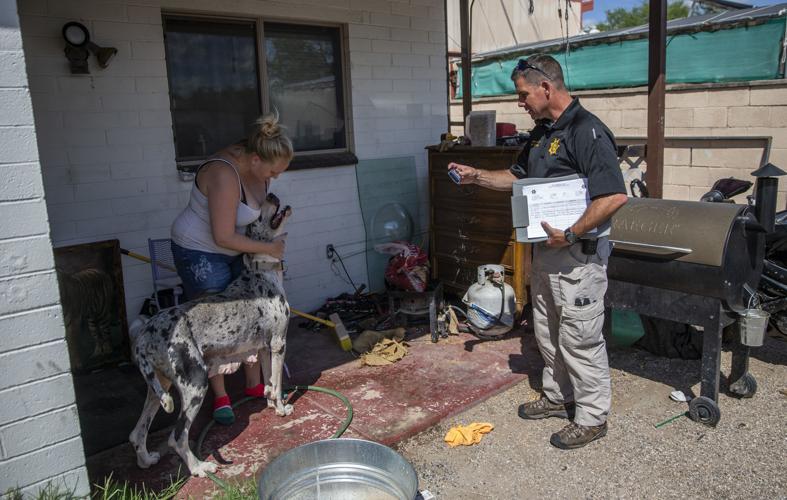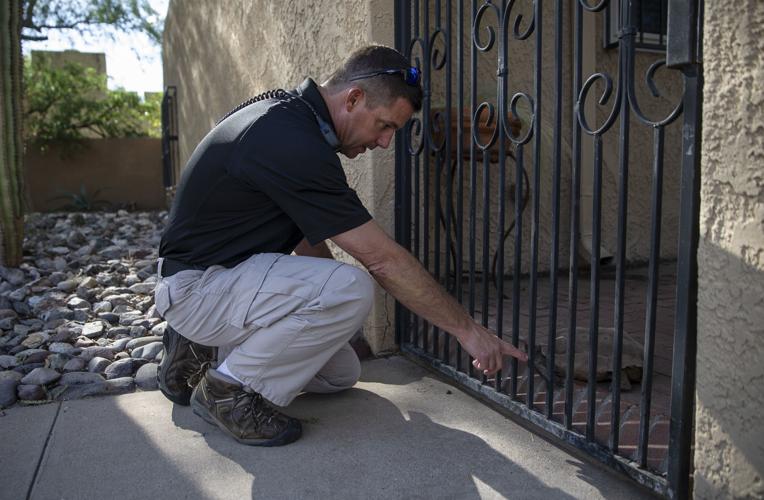In early July, a Tucson woman stumbled upon a troubling scene: a panting dog left inside an empty car in a grocery store parking lot.
The window was cracked, but with triple-digit heat, the dog showed signs of distress.
She wasted no time and quickly freed the dog.
Police and the Pima Animal Care Center were called, but by the time an animal protection officer arrived, Raja was inside the store and no longer suffering heat-related symptoms.
Animal protection officers were familiar with Raja’s owner, They’d responded to neglect complaints related to the dog’s skeletal frame, a complication from valley fever, which was being treated.
Despite complaints from the woman who pulled the dog from the car that the owner seemed drunk, because Raja was no longer in distress she was returned to her owner.
The ordeal, however, ended up on Facebook.
The now-deleted post ignited the community, eliciting anger from dozens of Tucsonans who were upset that Raja was given back to her owner.
The next day, Raja was relinquished to the shelter. The 2-year-old was adopted.
“We’re not law enforcement”
Last year, PACC’s 15 animal protection officers handled 26,325 calls, including 2,179 cruelty or neglect complaints, data provided by the shelter show.
In August, Animal Protection Services officers responded to 1,621 calls. That included 128 police assists, 602 stray animal complaints, 81 bite reports, 55 abandonment complaints and 112 calls about cruelty or neglect, according to PACC’s monthly report.
The caseload is staggering and APS officers’ hands are tied in many situations. One of them: State and local laws define animals as property, said PACC director Kristen Hassen-Auerbach.
“I think service expectations have risen and I think people don’t understand that we’re not law enforcement,” Hassen-Auerbach said. “We do not have the legal ability to walk onto someone’s property and take their animals.”
PACC’s animal protection officers wear badges and can enforce certain laws, but they’re not law enforcement officers and don’t have the same abilities as police. APS officers can handle most misdemeanor cases alone, but if the situation rises to the level of a felony, the police or sheriff’s department must be involved.
Tie-outs, which are illegal under Arizona law, are one of a very small number of situations in which an APS officer can take a dog without a warrant.
“People have a hard time grasping that dogs are property. If somebody’s TV is in the car, are you going to go in and remove it? No, because that would be stealing,” said Christina Snow, PACC’s Animal Protection Supervisor. “It’s a living creature, which tugs at all of us and makes us want to go in and remove it, but legally we cannot do anything unless it’s in distress.”
Arizonans can always call 911 if there’s an animal inside a vehicle during the summer: The call is top priority with police and APS officers, Hassen-Auerbach said.
Another way people can help is to take video evidence to back up what they’re reporting, whether it’s excessive barking or an aggressive dog.
“We don’t want people to be in physical harm, so they do need to be aware of their safety,” Hassen-Auerbach said. “For things like cruelty and neglect, we want people to always call us. We investigate every complaint.”

Pima Animal Control Center field officer Jim Hart pets a tortoise on Sept. 11, 2019. Neighbors were concerned about the pet’s welfare
New approach
In addition to the limits placed on APS officers under the law, PACC has taken a less punitive approach in recent years, opting to help pet owners rather than simply issuing citations for things like leash law violations and other issues.
In 2015, APS officers issued 3,401 citations, the most commonly issued ones including no license, no rabies vaccination, leash law violations and biting animals. The number of citations issued each year has dropped significantly, with a total of 647 issued in 2018. As of July 30, APS officers had issued 438 citations, with the most common reasons being leash law violations and biting animals.
PACC has implemented a fencing assistance program, with APS officers fixing or building fences to prevent roaming dogs.
PACC also has crisis shelter services available for pets whose owners face issues including hospitalization or housing transitions. APS officers can scan stray cats or dogs as they’re picked up around town, allowing the animals to be returned in the field without ever having to enter PACC’s shelter. And when time allows, APS officers participate in outreach for pet owners who are homeless or need extra support, distributing food and other supplies out of their trucks.
“We’re trying to build this giant pet safety net because we recognize that resources are so limited,” Hassen-Auerbach said. “A lot of the cruelty and neglect things that we used to just address punitively, we’re addressing them on the front end to get to them before they become cruelty and neglect.”
“We used to just punish people if they couldn’t afford medical care or food for their pets, but that didn’t solve the problem,” Hassen-Auerbach said. “Now we’re giving them support so that they can not just repeat the cycle.”
Hassen-Auerbach said PACC has started trying to get people to voluntarily surrender a pet when it’s clear they can’t care for it, rather than simply citing the owner.
The thousands of cruelty and neglect investigations that APS officers conduct each year are time-consuming, in many cases requiring repeat visits to make sure owners are complying. That process is stymied by the high load of true emergency calls for which APS officers have to drop everything and respond, Snow said.
With only five officers working each shift, regular calls can be tough to manage.
Of the 70 calls that APS officers respond to each day, 30 are true emergencies, including police assistance for owner arrests, evictions and welfare checks. Calls not related to police matters can include bat removal (since most carry rabies,) aggressive or injured strays, and animals hit by cars.

A forensic investigator was on hand for the removal of four dead dogs left in a trailer for several days. PACC’s 15 animal protection officers handled 26,325 calls last year.
“A time and a place to cite”
Sarah Girvin began working as an officer in January. While the job was new to her, the setting was not: Girvin worked as a vet tech in PACC’s clinic for nearly two years before becoming an officer.
Girvin has a veterinary science degree, but says she’d always been interested in law enforcement. Shortly after she started working at the clinic, PACC hit a save rate of 91%, its highest in years.
Her clinic job carried intense pressure and shifts often lasted 16 hours. Girvin knew she didn’t want to leave PACC, so she became an animal safety officer.
Girvin and two other APS officers handle all of shelter’s dangerous-dog investigations.
The officers work 10-hour shifts and are assigned to specific zones around Pima County to handle non-emergency calls. But zones don’t matter when an emergency call comes in.
The heavy emergency call load takes its toll on the officers’ daily workload. With some officers handling emergency calls and others making regular trips back to the clinic to drop off injured or ill animals, at times there’s only one officer patrolling all of Pima County.
During a recent ride-along, Girvin was diverted from responding to non-emergency complaints four times to respond to priority calls. The first time was to track down a sick-looking cat on a school playground that was gone by the time she arrived. Girvin was called off the second call after police found the person who left a dog inside a vehicle. The third call resulted in Girvin wrangling a barking dog outside so police officers could enter the home to check on the owner after neighbors said they hadn’t seen her in days. That call on the far east side pulled Girvin far away from her assigned zone, resulting in a cross-town drive to her fourth priority call for an injured cat on the southwest side.
Five hours after the start of Girvin’s shift, arrived at the address of the first non-emergency complaint of the day: a dog that had been abandoned at an apartment over the weekend. The dog couldn’t be seen or heard from outside the apartment, and Girvin didn’t have probable cause to look over the fence into the backyard. Had there been sounds indicating an animal in distress, Girvin could have checked the backyard. Girvin was restricted to posting a form on the apartment’s door. It said the occupant should call PACC within 24 hours, or APS would return.
Girvin echoed PACC’s sentiment about helping owners before citing them but said that she’s issued plenty of citations during her time on the job.
APS officers like Girvin have issued more than 100 citations in neglect cases, with lack of water, shelter or use of a tie-out being the major issues on those citations, PACC statistics for 2019 show.
Girvin was also the officer assigned to Raja’s case, saying that she had worked with the owners for several months before the incident in July.
Five months earlier, Girvin had seized Raja from its owner, but her owner successfully fought the seizure in court.
“If someone took your car, you have due process to try to get your vehicle back,” Girvin said, but expressed frustration with Raja’s situation and how it ultimately ended.
Investigations are all about building a case, Girvin said. If officers just go in and take a dog, the case won’t stand up in court.
A review of hundreds of pages of APS cruelty and neglect cases files from the past four years show that in most cases, officers make contact with pet owners several times during the course of an investigation. A series of phone calls and home visits by APS officers for each case is common, and many investigations stretch out over several months as the agency works to resolve the matter or build a strong court case, the review found.
“There’s a time and a place to cite, and when you’re first on the scene you have so much power over which way the case turns,” Girvin said. “We have a lot of decisions to make and handle a lot of cases. It’s stressful, but I love working in APS.”

Pima Animal Control Center field officer Jim Hart fills out paperwork in his truck. Animal protection officers wear badges and can enforce certain laws, but they can’t make arrests.
Enforcement and assistance
While APS officers can issue citations for misdemeanors, all felony cases must be investigated in conjunction with law enforcement and reviewed by county prosecutors prior to seeking grand jury indictments, said paralegal Laureen Pew, in response to a public-records request to Pima County.
Between Jan. 1, 2015, and July 30, 2019, law enforcement referred 69 defendants to the Pima County Attorney’s Office for review on felony charges related to violation of Arizona’s animal cruelty law.
Prosecutors filed charges against 37 of those people, according to data provided by the County Attorney’s Office. Of those cases, 21 were charged as felonies. For the other 16 defendants, the County Attorney’s Office opted to pursue misdemeanor charges.
During that same time period, law enforcement referred 43 defendants for misdemeanor violations of Arizona’s animal cruelty law, with the office pursuing charges against 39 of the defendants, the data show.
The number of felony cases prosecuted by the County Attorney’s Office has been on a steady decline for the last several years but appears to be on its way back up, according to the data. In 2015, the office prosecuted 12 felony animal cruelty cases. In 2016, the office prosecuted nine cases; in 2017, six cases and in 2018, there were five. But as of July 30, the County Attorney’s Office had already filed felony charges against five defendants and was on track to surpass last year’s total.
The County Attorney’s Office issued 689 misdemeanor charges against roughly 150 defendants for violations of the Pima County’s animal welfare ordinance during the time period, the data show. One defendant had 83 charges issued against him in a single case,but accepted a plea agreement and pleaded guilty to only two of the charges, court records show.
Violations to Pima County’s animal welfare code are handled by county prosecutors in Pima County Consolidated Justice Court and amount to roughly 20% of all misdemeanor animal cruelty and neglect cases filed in Pima County. Seventy-five percent of such misdemeanors are handled in Tucson City Court by the city prosecutor, and the remaining cases are handled by municipal courts in Marana, Oro Valley, Sahuarita and South Tucson, Pew said.
The majority of misdemeanor cases are filed by law enforcement officers directly in the respected municipal courts and don’t require prosecutors to review or make charging decisions in most cases, according to Pew.
Judges can issue court orders barring a person from owning a pet, but PACC officials say they haven’t yet encountered such a case. PACC can always refuse to adopt a shelter animal if a staffer feels it could be put in an unsafe situation, Hassen-Auerbach said.
PACC is in the process of rewriting some local ordinances, like a variance permit that would incentivize people to spay and neuter their pets while capping how many pets that person can own. The current kennel permit is designed for people who own and operate kennels, and there isn’t a permit for people who own multiple pets of their own.
“It will allow us to maintain better ongoing understanding of these houses that are inundated with multiple animals and lead to many of the cruelty and neglect cases that end up in the media,” Hassen-Auerbach said.
In addition to the ordinance changes, PACC has been making efforts to let the community know that its “enforcement” division is actually there to help.
Several years ago, PACC changed the name of the unit from Animal Control Services to Animal Protection Services, hoping to remove some of the stigma associated with the stereotypical dogcatchers of the old days. APS officers now wear polo shirts and their vehicles are being re-wrapped to list PACC support services.
“We want people to see us as not someone to be afraid of, but someone who can help them,” Hassen-Auerbach said.
Snow is hoping to get APS officers out into the community more to interact with the public, but with the high volume of calls, that’s been difficult.
“The more the community can see the good that we’re doing, what we’re trying to do and learn to trust us, the better off we are,” Snow said. “But we need to start there and it’s definitely going to take time.”








